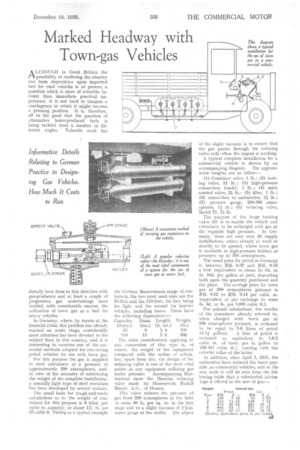Marked Headway with Town-gas Vehicles
Page 37

If you've noticed an error in this article please click here to report it so we can fix it.
ALTHOUGH in Great Britain the possibility of rendering the cOuntry free from dependence upon imported fuel for road vehicles is at present a question which is more of scientific interest than immediate practical importance, it is not hard to imagine a contingency in which it might become a pressing problem. It is, therefore, all to the good that the question of alternative home-produced fuels is being tackled from a number of different angles. Valuable work has
already been done in this direction with gas-producers and at least a couple of progressive gas undertakings have tackled, with considerable success, the utilization of town gas as a fuel for heavy vehicles.
In Germany, where, by reason of the financial crisis, this problem has already reached an acute stage, considerably more attention has been devoted to the subject than in this country, and it is interesting to examine one of the successful methods adopted for converting petrol vehicles for use with town gas.
For this purpose the gas is supplied in steel containers at a pressure of approximately 200 atmospheres, and, in view of -the necessity of minimizing the weight of the complete installation, a specially light type of steel container has been developed by several makers.
The usual basis for rough-and-ready calculations as to the weight of containers for this purpose is 0 kilos. per cubic m. capacity; or about 1i. lb. per 35 cubic ft, Taking as a typical example
the German Mannesmann range of containers, the two most used sizes are the 53-litre and the 110-litre, the first being for light and the second for heavier vehicles, including buses. These have the following dimensions :— Capacity. Diana. Length. Weight.
(litres.) (ins.) (ft. ins.) (lb.) 52 9 54 188 110 12 58 300 The main consideration applying to any conversion of this type is, of course, the weight of the equipment compared with the radius of action, but, apart from this, the design of the reducing valve is one of the most vital points in any equipment utilizing gas
under pressure. Accompanying illustrations show the Haweka reducing valve made by Hessenwerk Rudolf Maejrt, A.G., of Hessen.
This valve reduces the pressure of gas from 200 atmospheres at the inlet o some 40 lb. per sq. in. in the first stage and to a slight vacuum of 11-4-in.
water gauge at the outlet. he object of the slight vacuum is to ensure that the gas passes through the reducing valve only when the engine is working.
A typical complete installation for a commercial vehicle is shown by. an accompanying diagram. The approximate weights are as follow:—
(1) Container valve, 1 lb.; (2) tanking valve, 11 lb. ; (3) high-pressure connection (each), 1 lb. ; (4) main control, valve, 2,4 lb. ; (5) filter, 1 ; (6) connection to carburetter, 2i lb.; (7) pressure gauge, 2004300 atmospheres, 11 lb. ; (8) reducing valve, Model 71, 71 lb.
The purpose of the large tanking valve (2) is to enable the vehicle and containers to be recharged with gas at
the requisite high pressure. In Germany, there are now over 40 supply installations, either already at work or shortly to be opened, where town gas is available in high-pressure holders at pressures up to 350 atmospheres.
The usual price for petrol in Germany is between RM. 0.82 and RM. 0.38 a litre (equivalent to about is. (Id. to is. 10d, per gallon at par); depending both upon the quantity purchased and the place. The average price for town gas at 200 atmospheres pressure is RM. 0.12 to RM. 0.14 per cubic m. (equivalent at par exchange to some 3s. ocl. to 4s. per 1,000 cubic ft.).
For normal calculations, the smaller of the containers already referred to, when charged with town gas at 200 atmospheres pressure, is reckoned to be equal to 5-0 litres of petrol
(1-11 gallon). A litre of petrol is reckoned as equivalent to 1.6-2 cubic in, of town gas (a gallon to 256-321 cubic ft.), varying with the calorific value of the latter.
In addition, since April 1, 1035; the authorities have reduced the taxes payable on commercial vehicles, and in the new scale it will be seen from the following table that a substantial advantage is offered to the user of gas:—




















































































